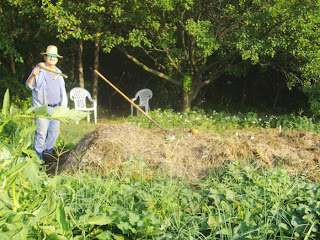
I lied. I stated in an earlier blog that after I dug my early potatoes in June I was going to replant that spud area in bush beans and get a second crop. We had some bush green beans in the freezer and the pole beans were covered with promising blossoms and I had run out of bush bean seed and would have to go into town to buy more etc., etc. so I changed my mind (that sounds much better than plain old “I lied”).
I had not gotten any free composted horse manure this year. As I looked at the empty ground where my potato patch had previously been, I decided that there was a silver lining in this grey cloud of no manure; there was an opportunity to be more self-sufficient and independent of outside help here. My garden now was considerably more fertile than the pure sand I had begun with in the first year of my retirement but still nowhere near what I wanted and needed. What I wanted was enough organic material mixed into the soil to give me a rich foot deep top soil. Yes… this empty potato patch would be where this year I would build the mother of all compost piles. From what grew mostly on my own property I would get the fertility up to a level where it would only need small increments of green manure and cover crops to maintain it in future years.
Compost requires both brown material (high in carbon) and green matter (higher in nitrogen.) For the brown material I had the weathered leaves that fell from my maples last fall. I also had about eight bales of straw that I had set melons on to sell by the roadside last summer and then used as winter insulation behind my north side crawlspace entry and snuggled around some outdoor water spigots to prevent freezing. This combination of brown material I laid about one foot deep over the bare potato patch. As for the green material, a garden, especially a melon field always has culls and bad plants which are a simple wrist pitch away from the compost pile. Cooking from garden produce leaves a lot of rinds, peels and cores; this is always a good addition to the pile. We only eat a small part of a corn plant, so once we had eaten or frozen the sweet corn, the husks, cobs and chopped stalks were all added to the pile. To chop the stalks I laid them all in the same direction on top of the compost pile and then went at them with a sharp hoe. The key word here is “sharp”.
I always let my lawn get a little tall before I take the riding mower to it, partly to save on high- priced gas, mostly because extra work is against my retirement religion, but also so I can get some nitrogen-rich grass clippings to rake up for my vegetable garden. Grass clippings work great as green material to heat up the pile and towards the end of the summer that is where they go. Earlier in the summer I prefer to use them as mulch around heavy feeding and perennial plants which need a mid-summer feeding side-dressing to keep producing, notably rhubarb and asparagus. Grass clippings are my manure substitute and a mulch to keep weeds down. After that purpose is served it can go in the compost pile.
My main source of green material by far was weeds, especially the ragweed (which grows rampant on our property), poke and what I perceived to be thistle plants (although my plant knowledge is so botanically challenged that in truth I cannot tell my thistle from my thassole.) Using young weeds to enrich my vegetable garden felt like a firefighter using back fires to fight fire. All the organic reading material indicates that succulent young weeds are good in the compost. Ragweed is the bane of every nasal allergy sufferer so it felt like I was killing two birds with one stone as I scythed them from our semi-wooded area and hedgerows. Scything was good aerobic exercise and I worked up a good lather when I wasn’t resting in the shade. When I say I composted weeds, I don’t mean any grasses. No crab grass or Johnson grass went into the pile. Those grasses re-root right away whereas the broad leaf weeds are fine as long as they are cut before they have set any seed.
I guess a picture is worth a thousand words so the photo shows the base of my mother of all compost piles where my early potatoes once grew. I will add material to that base the rest of the summer, till it into the soil late in the fall and then sow a green manure crop of ryegrass. Maybe I won’t sneeze quite as much either.

